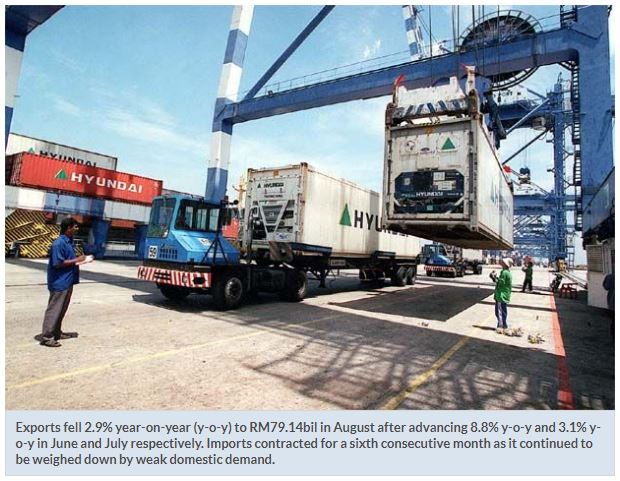Malaysia: 19.7% higher trade surplus
PETALING JAYA: Uncertainty will remain the keyword in Malaysia’s trade performance in the near future as the latest figures show that exports took a step back after advancing twice.
Exports fell 2.9% year-on-year (y-o-y) to RM79.14bil in August after advancing 8.8% y-o-y and 3.1% y-o-y in June and July respectively.
Imports contracted for a sixth consecutive month as it continued to be weighed down by weak domestic demand.
These led to a 19.7% y-o-y growth in trade surplus to RM13.23bil.
AmBank Research stressed that the return of a negative export growth is a setback for the ringgit, which has been under pressure recently.
It said that despite a steady goods surplus, continued net outflows on the service account resulting from a standstill tourism, should keep the overall current account surplus on a narrowing trend over the rest of the year.
“The current surplus almost halved to RM17.1bil in the first half of 2020 (1H20) from RM31.3bil a year ago.
“Our forecast for the full-year 2020 current surplus as a proportion of the gross domestic product (GDP) is 1.5%, down from 3.4% in 2019, ” it said in a report yesterday.
It added that against all odds of a record GDP plunge, narrowing current surplus, modest global oil prices and domestic political uncertainty, the ringgit has been performing well in a broad emerging market rally since June.
The rally, however, lost some steam in September, dented by a strong US dollar sentiment so far this month.
“The ringgit was a little disturbed last week by political risk in the run-up to the Sabah elections over the weekend.
“A clear win for the state coalition (Gabungan Rakyat Sabah) backed by Prime Minister Tan Sri Muhyiddin Yassin was a relief for markets as this further strengthened an otherwise shaky ruling coalition at the national level, ” the research house said.
CGS-CIMB Research said the goods account has turned out to be an unexpected source of support for the current account, which in turn provided an anchor for the ringgit through a period of financial market volatility in August.
It expected import appetite to gain momentum as domestic demand recovers, which would result in a more normalised goods trade surplus in 2021.
“At this juncture, we think Bank Negara is comfortable with its monetary policy stance and could wait out the recovery, particularly with the government set to unveil further policies to stimulate the economy in its medium to long-term recovery plan, Budget 2021 and 12th Malaysia Plan.
“We expect the central bank to stand pat on the Overnight Policy Rate (OPR) at its final meeting of the year on Nov 3, ” the research house said in a note yesterday, adding that it retained its forecasts of -2.0% gross exports and -3.5% gross imports in 2020, equating to a trade surplus of RM150bil.
Maybank IB Research said the lockdown rollback led to the resumption in the global supply chain that lifted trade flows, but recovery is fragile amid volatile trade as the Covid-19 rolls on.
It pointed out that recovery could waver amid new Covid-19 waves, as the composite purchasing managers indexes (PMIs) in September so far suggested some loss of recovery momentum, especially in the European Union, which dropped to 50.1 from 51.9 in August.
“The dip in EU’s composite PMI reflects lower services PMI of 47.6 as compared to 50.5 in August as manufacturing PMI rose to 56.8 from 55.6, indicating the impact on the services sector from new rounds of restrictions due to the emergence of new Covid-19 waves in the continent, ” Maybank IB said.
Source: https://www.thestar.com.my/business/business-news/2020/09/30/197-higher-trade-surplus


 English
English




